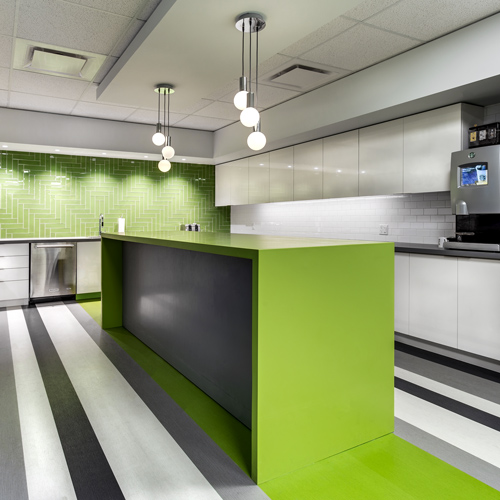Most of the time, people spend about a third of their day at work. That’s part of why Christian Bigsby and the real estate and facilities team at GlaxoSmithKline (GSK) have made it their mission to ensure employees and customers spend that portion in the most inspiring and efficient environment as possible.
Bigsby is the senior vice president of worldwide real estate and facilities at GSK, a science-led global healthcare company with a focus on the development and manufacturing of innovative medicines and vaccines, as well as consumer healthcare products. He and his team have the important task of turning the company’s real estate spaces from an overhead cost to a competitive advantage.
“Real estate is one of the highest costs of the business, depending on the industry you’re in,” Bigsby explains. “It’s interesting that, historically, real estate hasn’t received much creative attention from senior leaders. My team makes sure we are providing space that really works for our businesses—allowing them to run effectively—while keeping up with the pace of innovation to really prepare us for the future.”
One of the major challenges Bigsby and his team face is balancing the cost of the building with the operations of the workplace and services within its doors.
“We should never provide really cheapened assets nor a horrible workplace experience; good design combined with good services can provide a competitive advantage at a competitive price,” Bigsby says. “My team has been successful in the last couple of years striking a much better balance of paying attention to the cost and the quality issues, not cost versus quality.”
His team’s influence—not to mention the trust they have gained throughout the company—didn’t happen overnight. In fact, Bigsby views it as a 15-year marathon they ran to stand out from everyone else looking to change their work environment.
“It wasn’t until we put our efforts into a change management program led by senior leaders that people began to see their design campaigns not just as a run-of-the-mill cost cutting measure, but instead as a way to help the company move forward and increase its competitive advantage,” Bigsby says. “When our company presidents give personal testimonials on the inherent value of collaborative designs, it really resonates with our employees. When the business takes ownership of change there is a powerful buy-in to the new designs. As a result, we haven’t just implemented design changes; we have changed the way people work.”
Of course, with a company as large as GSK (nearly 100,000 people), it’s impossible to carve out a unique workspace for every employee. However, Bigsby still manages to get creative and come up with workspace designs that fit a wide variety of employee preferences and work styles. They also fit the requirements of critical, specialized work environments. It’s all part of GSK’s essential design component: choice. In every work environment, employees can choose where they want to work (collaborative, quiet, communal, informal) at any particular time throughout the day.
“Paying attention to those individual work styles is very important in terms of how we shape the variety,” he says. “The same way that you’d lead an organization, you pay attention to those preferences and styles. But eventually, [you] have to, within reason, come to a reasonable corporate or team dynamic and team program, and embrace both diversity and an element of common mission.”
The trust that Bigsby’s team has earned over the years has come in handy during the company’s recent three-part joint venture with Novartis. When it came to the real estate integration aspect of the deal, GSK closed 90 percent of the transactions within the first 12 months. In 1995, comparable real estate integration took three years and cost the company millions of dollars.
Bigsby’s real estate solution made the integration faster and cheaper. The idea was to take advantage of the team’s design standards and move people to buildings that GSK already had. This saved time and money since there wasn’t a need to make a major reinvestment in the buildings. There’s some work involved for Bigsby and his team, but on the business side, GSK did not have to build out any new spaces or create new offices. The fast turnaround was possible because of the flexible designs of the work environments created by Bigsby’s team.
“In the course of about 20 years, we moved from something that took us three years to something that took us less than a year to respond to the same sort of scale and scope of an integration,” Bigsby says. “We made a decision to change the way we looked at the workplace. Even though it was seen as, ‘I don’t understand why we’re doing this’ in the early days, it has allowed us to respond with, ‘We did this integration with mergers in a dramatically accelerated fashion.’”
When Bigsby looks at what’s to come in the real estate industry, he believes the way to stay on a successful path is to continue to innovate and think of ways that real estate can become a genuine competitive advantage. Otherwise, it’s their business that will be disrupted.
“Uber comes along and shows an established industry where you don’t need a large overhead of fleet vehicles to provide transportation services,” he says. “I think we should never forget [that], in a role like mine, real estate is an overhead function. Our responsibility is to move it away from that overhead cost and move it into something that becomes a competitive advantage for the company.”


